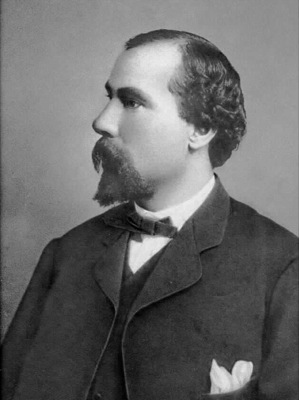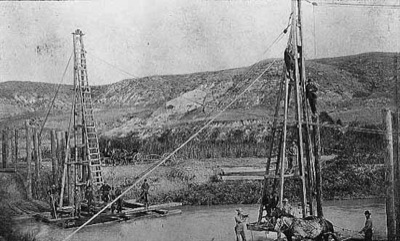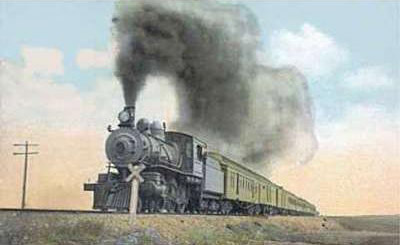In a misguided attempt to find a climate that would help him recover from the tuberculosis that would kill him the following year, Henry David Thoreau visited St. Paul, Minnesota, in 1861. It would not be surprising if, while in St. Paul, Henry encountered an earnest young man working in the shipping business.

James J. Hill in 1864.
Born in 1838 in what was then called Upper Canada about 50 miles from Toronto, James Hill (he himself added the middle name, Jerome) “took a notion to go” to St. Paul in 1857. Though his schooling had ended at age 14 when his father died, he quickly advanced in the shipping business as a clerk, bookkeeper, and manager.
Due to the waterfalls of St. Anthony, St. Paul was the head of navigation on the Mississippi River, so freight had to be transfered between steamboats and wagons and, later, trains. In 1866, Hill built a warehouse on the Mississippi that greatly eased such transfers. By 1872, he was a partner to Norman Kittson–his elder by 24 years–in a steamboat monopoly on the upper Mississippi and also had a local monopoly in the anthracite coal business.
The “panic” or recession of 1873 caused the failure of many railroads, including the St. Paul & Pacific, “two streaks of rust” that was attempting to build north from St. Paul. Hill decided to take over the bankrupt line, and in partnership with Kittson and two acquaintances from Canada, Donald Smith and George Stephen, Hill persuaded the main creditors of the St. Paul & Pacific to sell them the railroad on little more than a promise of a share of future profits.
Since Kittson was ready to retire and the Canadians lived hundreds of miles away, Hill became general manager. He quickly built to Grand Forks and Devils Lake, North Dakota, accessing hundreds of thousands of acres of prime wheat growing country. The St. Paul & Pacific came with a small land grant, which Hill sold to settlers at rock-bottom prices with the goal of putting farmers on the land who would grow crops that his railroad could ship. The railroad was soon shipping close to a quarter of the spring wheat grown in the U.S. and paying its shareholders 8 percent annual dividends.
Meanwhile, Smith and Stephen became the leading movers behind the Canadian Pacific Railway, which was chartered by the Canadian government to build from Toronto to Victoria, BC. Hill hoped they would use the renamed St. Paul, Minneapolis and Manitoba Railway as part of the route, but the Canadian government insisted on an all-Canadian route. Disappointed, Hill decided to build his own line to the Pacific.
The Union Pacific, Central Pacific, Northern Pacific, Santa Fe, and Canadian Pacific transcontinental railroads were all built with huge land grants and cash subsidies from the U.S. and Canadian governments. Hill realized that these grants were actually a disadvantage for the railroads, for they were built to get the subsidies, not to move freight.
Long before most other railroad managers, Hill also realized that the nature of the railroad business was changing from a premium service (like air freight today) to a commodity service requiring heavy-duty rails, locomotives, and freight cars. “What we want is the best possible line, shortest distance, lowest grades, and least curvature that we can build between the points to be covered,” he told his engineers.

Bridging the Missouri River in Montana. Much of the line in eastern Montana went across Indian reservations; Hill paid the Indians 50 cents an acre for right of way.
On top of understanding this big picture, Hill had an incredible mind for detail. In 1886, he extended the Manitoba road to Minot, ND (named after one of Hill’s top lieutenants). The following summer, he built a line some 550 miles from Minot to Great Falls, MT — more rail miles from one end of track than have ever been built in one season before or since.
In 1889, Hill signaled his intentions to continue further west when he picked a new name for the railroad: the Great Northern Railway. By January, 1893, his tracks reached Seattle, just in time for the nation’s next big recession.
The panic of 1893 put almost every railroad in the West into bankruptcy. Skeptics said the Northern Pacific and other bankrupt roads, being in receivership, would have a competitive advantage over “Hill’s folly” because they did not have to meet their bond obligations. Hill had to pinch pennies, but his rail line was so well built that he was still able to ship at lower prices than his competitors.

The Great Northern Flyer in Montana around 1900.
The Great Northern is the only transcontinental railroad to be built without subsidies that never went into receivership. (I don’t count the relatively tiny St. Paul & Pacific land grant because Hill had to buy it, along with the railroad, from the rail line’s creditors.) The Milwaukee Road also received no subsidies, but went bankrupt soon after reaching Seattle. All the others received enormous subsidies and all but the Southern Pacific and Canadian Pacific went bankrupt at some point, some of them more than once.
When the leaders of one community offered to give Hill $65,000 to build a line to their city, Hill wrote,
“It has not been our policy at any time to burden the communities along our lines with additional taxes for railroad facilities. If the people [in your] county will give us moral support in procuring what right-of-way we require at fair and reasonable prices, we will build the road and have it completed this year on condition that the bonds voted for the $65,000 be returned to the officers of the county and by them burned or destroyed. The people of your county will largely have to support the road when it is built and the additional burden of the [bonds] would be a hardship to them.”
Hill was not averse to accepting — and occasionally demanding — free rights-of-way into cities. But instead of relying on cash and land-grant subsidies, Hill built in stages — first to the wheatfields of Minnesota and the Dakotas, then the mines of Montana, and finally the port of Seattle — letting the revenue from each stage pay for the next. The result, for many years, was one of the strongest and most profitable railroads in the West.
Next: The Empire Builder








How did they expect to get the CP to Victoria?
In 1866, Hill built a warehouse on the Mississippi that greatly eased such transfers. By 1872, he was a partner to Norman Kittson–his elder by 24 years–in a steamboat monopoly on the upper Mississippi and also had a local monopoly in the anthracite coal business.
Monopolies are good because they don’t involve government intervention.
They would get to Victoria via rail ferry which was common in the late 19th and early 20th centuries, with some still in operation.
Regarding Hill’s monopoly it should be noted that his monopoly was transitory and not permanent. Most monopolies exist becauase of explicit government intervention and legal support.
ROT, Hill was born in what is now Ontario, not Quebec.
Your understanding geography seems to be is as bad as your understanding of history, economics and hard sciences.
prk166,
At one point, the CP actually was considering building a bridge to Vancouver Island — which may show more about how ignorant people in eastern Canada were about western geography than anything else.
the highwayman,
You are right about Ontario. I remembered he was born in upper or lower Canada, and confusingly lower Canada is higher on the map than upper Canada, so I got it backwards.
Even the early road history of the area is interesting too.
http://www.oregon.gov/ODOT/CS/SSB/Oregon_Trail.shtml
Though to write about Hill with out mentioning the “Hill lines” it some thing else.
http://www.tourolaw.edu/Patch/Northern/Brewer.asp
Antiplanner, thanks for the interesting discussion of the Great Northern Railway.
To some extent, it reminds me of the Virginian Railway (http://en.wikipedia.org/wiki/Virginian_Railway – yes, I have mentioned it here before), even though the VGN was much shorter than the Great Northern.
Adam Smith, The Wealth of Nations in 1776:-
“Whatever exigency of the state, turnpike tolls might be intended to supply, that
exigency would be chiefly supplied at the expense of the poor, not the rich; at the
expense of those who are least able to supply it, not of those who are most able.”
Could we apply this same logic to rail lines too?
Hiwayman: Could we apply this same logic to rail lines too?
JK: NO! passenger rail is much more expensive than roads. There is no public purpose served by wasting money on rails when roads serve more people, are more versatile and cheaper.
Question: What does the railroad use when the line is blocked:
Answer: Buses on ROADS!
Thanks
JK
Since that’s your classic subjective objectivism, the real answer then is yes.
Railroads should be treated equally as roads.
Also at times passenger trains will take detours on to other lines.
Though roads have been blocked at times too and the only means through an area has been by rail.
Speaking of purpose.
What government does for one it should do for all;
What government does not do for all, it should do for none.
What government does for one it should do for all;
What government does not do for all, it should do for none.
========
Great idea
Lets start subsidizing auto users as much as we do transit users
Craig that’s so crazy, that might just work.
So how many roads do you want to close?
highwayman: Railroads should be treated equally as roads.
JK: Good to see you are starting to see the light. Passenger rail users should pay 100% of their actual cost, just like road users do today.
Thanks
JK
[/ignore]
just like road users do today.
*snork*
Ahhh…it’s good to read comedy during the day! Makes life so much better. Too bad the tea came out thru my nose tho…
DS
[ignore]
JK, that was funny!
Is your motto some thing akin to, “God bless, the IRS”?
Pingback: » The Antiplanner
Pingback: James J. Hill, Empire Builder » The Antiplanner
Pingback: James J. Hill, Conservationist » The Antiplanner
Pingback: Obama’s Model for High-Speed Rail: Crédit Mobilier » The Antiplanner